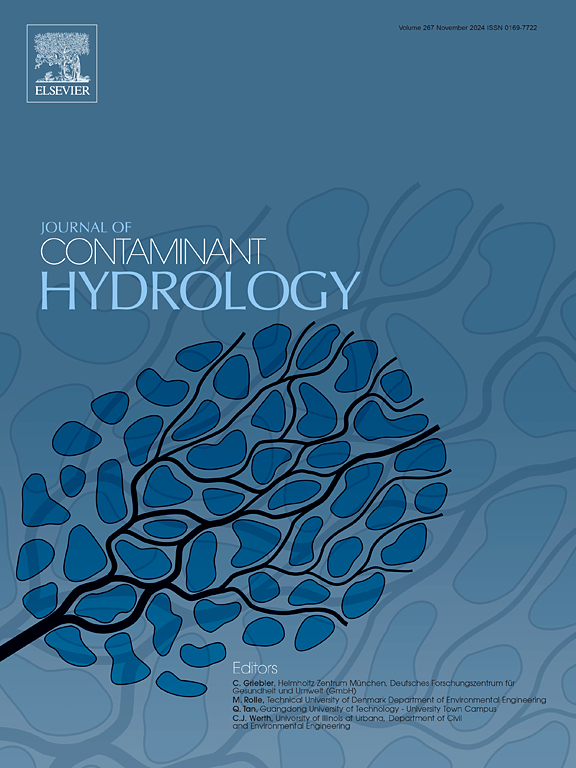Concentration-discharge relations and transient metal loads reveal spatiotemporal variability in solute-generation mechanisms in a mine-affected watershed
IF 3.5
3区 环境科学与生态学
Q2 ENVIRONMENTAL SCIENCES
引用次数: 0
Abstract
Concentration-discharge (CQ) relations are commonly used to understand geochemical and hydrologic controls on the generation of solutes in watersheds. Despite the widespread application of CQ relations, this technique has been infrequently applied to acid mine drainage (AMD) sites, but the CQ framework may allow mechanistic understanding of remedial outcomes such as impoundment of water within underground mines. Results of CQ analyses and changes in metal loads in an AMD affected watershed in Colorado, USA indicate that dissolved loads increased at many individual locations following water impoundment within mine workings. Although increased loads were observed at most individual locations, these increases were offset by a large decrease in loading from the largest mine. A loading analysis that included data from an instream monitoring location showed a statistically significant decrease in Fe and Zn after bulkhead emplacement, indicating a net positive effect of bulkheads. Streams generally displayed dilution CQ patterns whereas mines and springs showed either flushing or chemostatic patterns prior to bulkheading, which transitioned to chemostatic patterns following bulkheading, indicating a transition from dynamic to equilibrium geochemical processes. Saturation indices for sulfide and secondary minerals indicated that mines and springs were near equilibrium for phases including schwertmannite, fluorite, and gypsum. Saturation indices vary through time for mines suggesting progressive leaching of sulfide minerals as the mass of available minerals in the mine workings decreases. Together, these diverse analyses provide an integrated understanding of the variability in solute generating processes in this watershed and may inform remediation plans for similarly affected sites by indicating the nature of mineralogic controls on water quality.

浓度-流量关系和瞬态金属载荷揭示了矿井影响流域溶质生成机制的时空变异性
浓度-流量(CQ)关系通常用于理解地球化学和水文对流域溶质生成的控制。尽管CQ关系得到了广泛的应用,但该技术很少应用于酸性矿井排水(AMD)场地,但CQ框架可能允许对诸如地下矿井蓄水等补救结果的机制理解。CQ分析结果和美国科罗拉多州一个受AMD影响的流域的金属负荷变化表明,在矿山作业蓄水后,许多个别地点的溶解负荷增加。虽然在大多数个别地点观察到载荷增加,但这些增加被最大矿井的载荷大量减少所抵消。一项装载分析显示,在安装隔板后,铁和锌的含量显著降低,这表明隔板的净效应是积极的。河流普遍表现为稀释型CQ模式,而矿井和泉水在舱壁前表现为冲刷型或恒化型,舱壁后转为恒化型,表明地球化学过程由动态向平衡转变。硫化物和次生矿物的饱和度指标表明,矿体和矿泉的石、萤石、石膏等相接近平衡。矿井的饱和度指数随时间的变化而变化,表明随着矿井工作中可用矿物的质量减少,硫化物矿物会逐渐浸出。总之,这些不同的分析提供了对该流域溶质生成过程变异性的综合理解,并可能通过指示矿物学对水质控制的性质,为类似受影响地点的补救计划提供信息。
本文章由计算机程序翻译,如有差异,请以英文原文为准。
求助全文
约1分钟内获得全文
求助全文
来源期刊

Journal of contaminant hydrology
环境科学-地球科学综合
CiteScore
6.80
自引率
2.80%
发文量
129
审稿时长
68 days
期刊介绍:
The Journal of Contaminant Hydrology is an international journal publishing scientific articles pertaining to the contamination of subsurface water resources. Emphasis is placed on investigations of the physical, chemical, and biological processes influencing the behavior and fate of organic and inorganic contaminants in the unsaturated (vadose) and saturated (groundwater) zones, as well as at groundwater-surface water interfaces. The ecological impacts of contaminants transported both from and to aquifers are of interest. Articles on contamination of surface water only, without a link to groundwater, are out of the scope. Broad latitude is allowed in identifying contaminants of interest, and include legacy and emerging pollutants, nutrients, nanoparticles, pathogenic microorganisms (e.g., bacteria, viruses, protozoa), microplastics, and various constituents associated with energy production (e.g., methane, carbon dioxide, hydrogen sulfide).
The journal''s scope embraces a wide range of topics including: experimental investigations of contaminant sorption, diffusion, transformation, volatilization and transport in the surface and subsurface; characterization of soil and aquifer properties only as they influence contaminant behavior; development and testing of mathematical models of contaminant behaviour; innovative techniques for restoration of contaminated sites; development of new tools or techniques for monitoring the extent of soil and groundwater contamination; transformation of contaminants in the hyporheic zone; effects of contaminants traversing the hyporheic zone on surface water and groundwater ecosystems; subsurface carbon sequestration and/or turnover; and migration of fluids associated with energy production into groundwater.
 求助内容:
求助内容: 应助结果提醒方式:
应助结果提醒方式:


